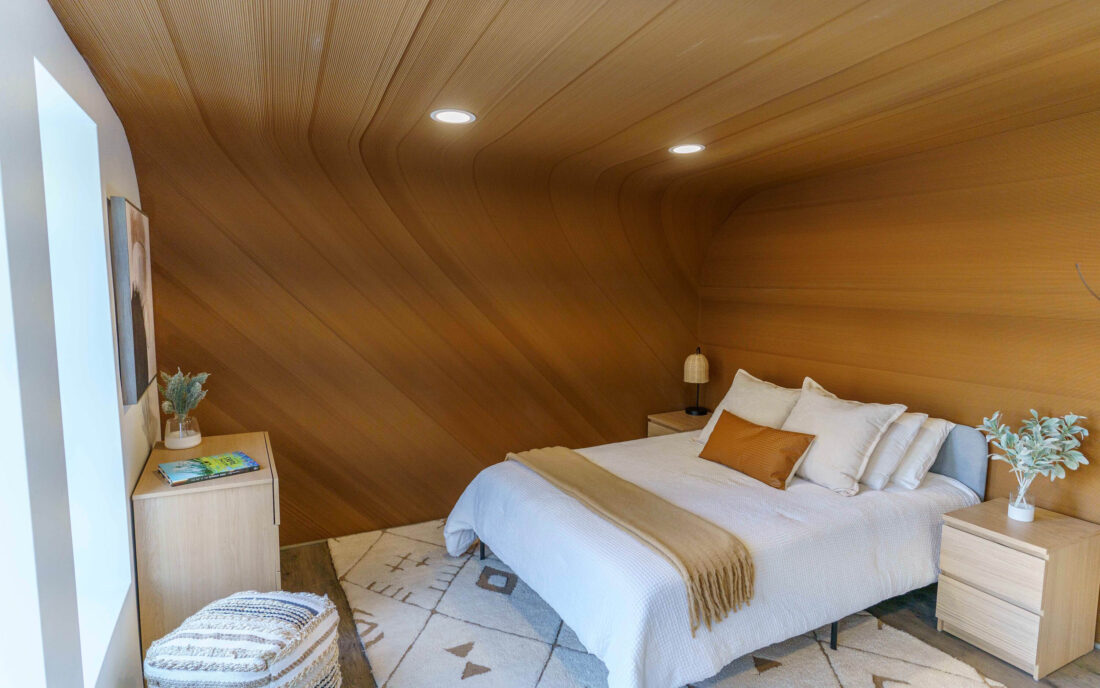3D-printed home to help solve affordable housing crisis

People tour the University of Maine Advanced Structures and Composites Center’s 3D printed home at its unveiling on Nov. 21. (Provided photo — Sawyer Loftus/BDN)
ORONO, Maine — Engineers at the University of Maine have created the first 3D-printed house that is completely derived from waste woods, and it could be the key to solving the affordable housing crisis in Maine and beyond.
While 3D-printed houses are not a new phenomenon, the University of Maine’s Advanced Structures and Composites Center’s new “BioHome3D” is a fresh take that combines 3D-printing technology with materials that are completely recyclable and renewable, according to the center’s director, Habib Dagher.
Leaders from the University of Maine System; Gov. Janet Mills; U.S. Sen. Susan Collins; Jeff Marootian, senior advisor for the United States Department of Energy and nominee to be the new assistant secretary of the department; Xin Sun, associate laboratory directory of energy science and technology at Oak Ridge National Laboratory; and Maine Housing Director Daniel Brennan helped Dagher unveil the newly constructed home on the University of Maine’s campus Monday.
The project was developed with Maine Housing and using funds from the Department of Energy.
In Maine, there’s a need for nearly 20,000 affordable homes for low-income individuals, according to the National Low-Income Housing Coalition. The new BioHome3D is an answer to Maine’s as well as the country’s housing crisis, Dagher said.

The bedroom of the University of Maine Advanced Structures and Composites Center’s 3D printed home at its unveiling on Nov. 21. (Provided photo — Sawyer Loftus/BDN)
“Are we going to solve the problem overnight by printing the first home? No,” he said. “This is the beginning of a road, where we’re going to get there by doing a lot of research in the future.”
The house is a simple one-bedroom, one-bathroom with a combined kitchen and living room and totals about 600 square feet. It was designed to meet the needs for low-income, affordable housing outlined by Maine State Housing Authority, Dagher said.
Other 3D housing projects have been limited, mostly printing either just the concrete foundation or, in some cases, some of the walls. But BioHome3D is completely constructed from pieces printed by the composite center’s 3D printer.
The material used to print the home is made from wood flour, or residuals, which is the waste left over in sawmills. That flour is mixed together with a binding agent made from corn and then melted down to make the material that the printer uses.
The material, developed by the center, was designed to use resources that so far haven’t been used in Maine, bolster the state’s forest products industry and be environmentally friendly, Dagher said.
“There are 1.2 million tons of wood residuals in our sawmills right now, in our region, that could go to print houses,” he said.
Mills praised the promise of the project and what the future automation of the composites center could do to bolster the production of these housing units to aid struggling Mainers.
“There are a lot of ideas about how to address the homelessness issue, different kinds of shelters around the state, boarding homes, tiny homes and whatnot, but this certainly is one of the things that has a lot of potential,” she said.
Marootian, with the United States Department of Energy, said the prospects of the project are a “game-changer” when it comes to producing affordable housing and taking care of the environment.
“This exciting achievement proves what’s possible when we work together to foster game-changing innovations and technologies and regional products and partners, which will be required to accelerate our future into the clean energy future that we want,” Marootian said.
While no one has yet slept in the house, Dagher said a series of sensors and other devices have been installed throughout the building to track how the home does in different temperatures.
“The first thing it needs to do is to get through a good old Maine winter,” Dagher said. “We’ve got a bunch of sensors on the house to look at the strain. We also have sensors to look at its heat performance and thermal performance in the house, moisture and humidity. We will learn as much as we can, and then use what we learn to make it better.”
